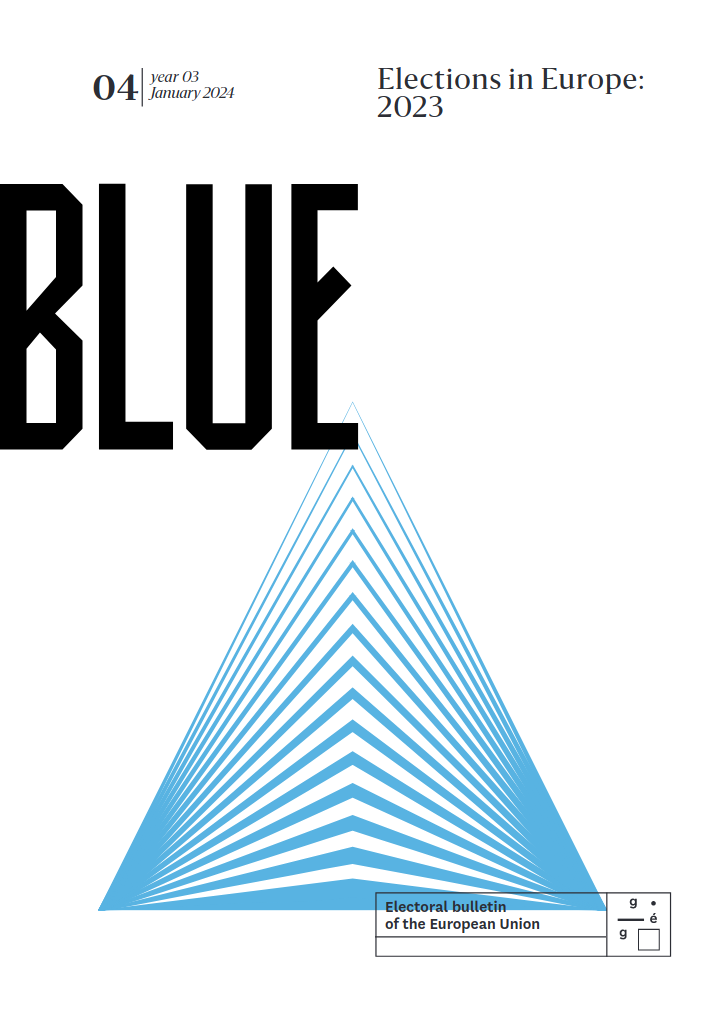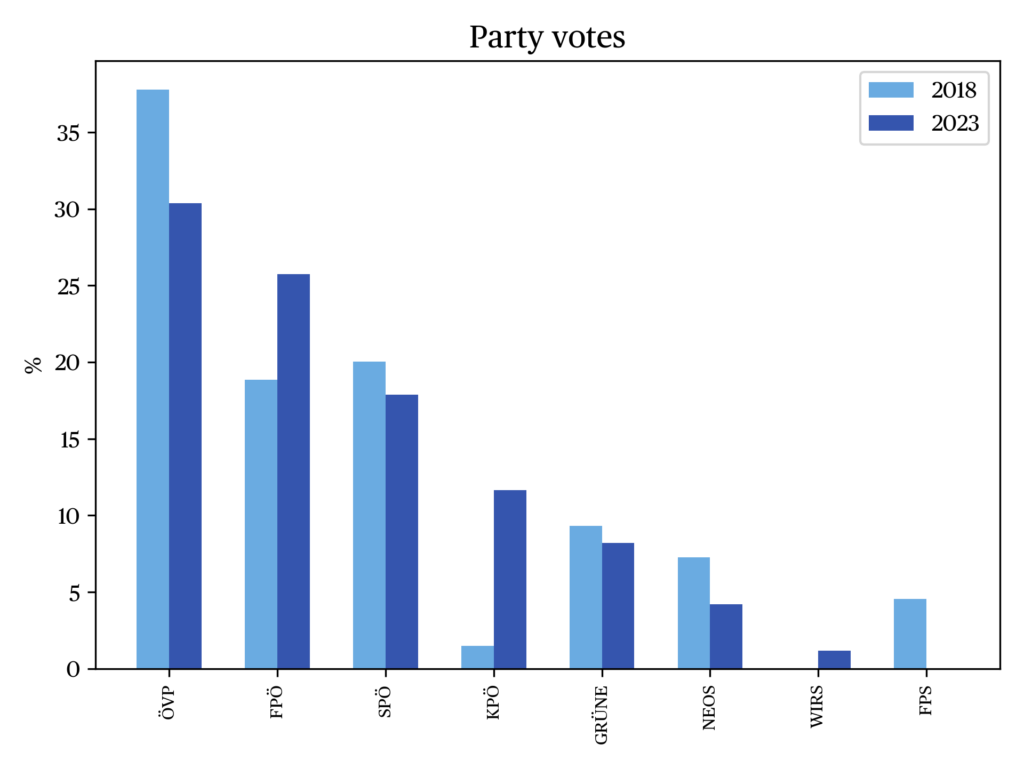Regional election in Salzburg, 23 April 2023

Eric Miklin
Associate Professor at the University of SalzburgIssue
Issue #4Auteurs
Eric Miklin
Issue 4, January 2024
Elections in Europe: 2023
Introduction
The third victory in a row for the Austrian People’s Party (ÖVP), the 2023 Salzburg State Parliament election did not bring a new leading party to the region. It did, however, give the ÖVP a new coalition partner in the form of the right-wing populist Freedom Party of Austria (FPÖ), and led to a general strengthening of the right-wing and left-wing margins of the party spectrum. After a brief historical review, the following analysis offers an assessment of the election results in the light of the political context in which the election took place.
Historical and institutional background
In the academic debate, Austria is generally regarded as a weak federal state, a ‘federation without federalism’ (Erk 2004), mainly due to the limited legislative competences of the state parliaments, the Landtage. Political practice only partially confirms this view, as the states do have far-reaching competences in the area of executive power (‘executive federalism’) and do exert influence on legislation through the informal body of the Conference of Provincial Governors (Karlhofer 2009). Nevertheless, provincial elections in general, and Salzburg elections in particular (Fallend 2018), are quite strongly influenced by federal political trends and discussions.
Historically, the ÖVP was the dominant political party in six of the nine federal provinces. In Salzburg, too, it won all elections from 1945 to 2004 and provided the head of government, the Landeshauptmann. In the last 20 years, however, a number of shifts have become apparent. In the 2004 and 2008 elections, for example, the ÖVP only came in second behind the Social Democratic Party of Austria (SPÖ). Although it remained in government during this period, it had to cede the chairmanship of the coalition to the SPÖ. In the following, 2013 election, the ÖVP suffered a massive loss of votes (-7.5 percentage points) after a wide-ranging financial and speculation scandal within the provincial government was made public. However, as the SPÖ lost even more votes (-15.5 percentage points), the ÖVP was able to regain first place and form a three-party coalition under the leadership of Landeshauptmann Wilfried Haslauer (ÖVP) together with Die Grünen (The Greens), a party massively strengthened not least by the financial scandal after the election, and the populist and economically liberal protest party Team Stronach (TS), which entered the Landtag for the first time.
In the last election in 2018, the Salzburg ÖVP, boosted by the popularity of its then very successful federal party (Fallend 2018), was not only able to defend the provincial governor’s seat. For the first time since 1984, it also achieved a significant gain in votes (8.8 percentage points). The ÖVP and the Greens continued their cooperation, forming a coalition with the liberal party New Austria (NEOS) that was represented in the Salzburg state parliament for the first time. The TS successor party Liste Hans Mayr (MAYR) failed to re-enter parliament.
Political background
The starting positions of the five parties already represented in the Landtag before the 2023 elections were very different. The Austrian People’s Party (ÖVP) was generally expected to suffer significant losses, as the federal party had lost a lot of popularity compared to 2018 following numerous political scandals and the resulting resignations (including those of several Federal Chancellors). In addition, Governor Haslauer’s policies during the Covid-19 pandemic were also criticised from many sides as either too timid or too restrictive. The SPÖ’s election campaign was overshadowed, among other things, by an ongoing and, in the run-up to the election, escalating debate about leadership and direction at the federal level. The 36-year-old SPÖ candidate David Egger was only moderately successful in positioning himself as an alternative Landeshauptmann in the election campaign. NEOS also struggled with internal conflicts (in this case within the provincial party) as well as with its position as the smallest coalition partner; according to the polls, the party could have to worry about its capacity to re-enter the Landtag.
By contrast, the Greens’ and FPÖ’s starting position was much more favorable. In the election campaign, the former focused on its core issue of climate change, which was also prominently discussed in the public space, and polls predicted a solid result for them. The right-wing populist FPÖ, after three successful regional elections in the preceding months and its months-long lead in national polls, was also predicted to make significant gains in Salzburg. The party also benefited from the fact that the populist parties Freie Partei Salzburg (FPS) and MAYR, which failed to (re-)enter parliament in 2018, did not stand this time. Of the remaining three parties running state-wide – the list Menschen, Freiheit, Grundrechte (MFG), which was critical of the Covid-19-measures, its spin-off Wir sind Salzburg (WIRS) and the Communist Party of Austria (KPÖ+) – only the latter was considered to have a chance of (first-time) entry into the state parliament (Salzburger Nachrichten 18 March 2023).
Issue-wise, the election campaign was dominated by debates on measures to combat the high inflation resulting from the war in Ukraine and, more specifically, possible strategies to curb energy and rent costs, with the latter issue being particularly prominent in the city of Salzburg. On the one hand, these two issues played into the hands of the KPÖ+, whose top candidate Kai-Michael Dankl had already made a name for himself in the municipal council of the provincial capital on the issue of housing and social affairs. At the other end of the spectrum, the FPÖ demanded an end to “inflation-driving” sanctions against Russia, a reduction in what they perceived as excessive measures promoting the transition to renewable energy sources, as well as coming to terms with allegedly overly restrictive measures taken by the provincial government during the Covid-19 pandemic. While the Greens emphasised the necessity of continuing and accelerating the transition to renewable energy, the SPÖ and NEOS found it difficult to set clear thematic priorities for the reasons mentioned above. The election campaign of the Austrian People’s Party (ÖVP) also focused more on the person of the incumbent Landeshauptmann and the associated message of stability and continuity, rather than on concrete substantive demands.
The question of possible post-election coalitions played an increasingly important role, especially towards the end of the election campaign, not least because a continued parliamentary majority for the existing coalition was uncertain. Unlike in previous state elections in Lower Austria, Carinthia and Tyrol, in Salzburg neither the ÖVP nor the SPÖ ruled out a coalition with the FPÖ in advance. On his side, the FPÖ reduced its attacks on the ÖVP in the campaign finale and clearly stated its ambition to govern (Salzburger Nachrichten 20 April 2023).
The result
The election result was in line with general expectations in many areas (see “the data”). As predicted, the ÖVP lost significantly (-7.4 percentage points), while the FPÖ, with a plus of 6.9 percentage points, achieved its best result ever in a Salzburg state election. The SPÖ again undercut its historically worst result of 2018 with just under 18 per cent. While the Greens were able to largely maintain their share of the vote with 8.2 per cent, NEOS fell from 7.3 per cent in 2018 to only 4.2 per cent this time, failing to reach the 5 per cent threshold needed for obtaining seats in the Landtag. A big surprise, however, was the unexpectedly strong performance of the Communist Party. Not only did the KPÖ manage to enter the Landtag, but, with 11.2 per cent, it even came in fourth, finishing ahead of the Greens (Filipp 2023).
In terms of Landtag seats, the previous government consisting of the ÖVP (12, minus 3), Greens (still 3) and NEOS (minus 3) obtained only fifteen seats, failing short of the required parliamentary majority (19 seats). A potential left-wing coalition of SPÖ (7, minus 1), KPÖ (plus 4) and Greens, as well as a coalition of the FPÖ (10, plus 3) and SPÖ remained clearly below this threshold. The only realistic coalition options therefore involved cooperation between the ÖVP and the FPÖ (22 seats) or between the ÖVP and the SPÖ, which however only narrowly secured a majority by obtaining exactly 19 seats.
Geographical comparisons show similar patterns as in 2018. Despite its losses, the ÖVP manage to obtain the largest number of votes in all six districts. The relative strength of left-wing and right-wing parties varied significantly. The (centre-)left parties SPÖ, KPÖ and the Greens did significantly better in the provincial capital Salzburg, as well as north and south of it, than in the rest of the country, while the (centre-)right-wing parties ÖVP and FPÖ were particularly successful in the southeast and west (Figure a). These patterns correlate strongly with the different population densities in these areas. While the ÖVP and FPÖ performed comparatively better in sparsely populated regions in the countryside, the Greens, KPÖ, SPÖ and to some extent NEOS achieved their best results mainly in or around the provincial capital of Salzburg and the next largest cities such as Hallein, Saalfelden, Seekirchen or Zell am See. Compared to 2018, however, it is noticeable that the KPÖ+ was able to make above-average gains (from 1.2 to 21.5%), especially in the city of Salzburg (home to around a quarter of all eligible voters), even achieving second place there behind the ÖVP. Conversely, the FPÖ was only able to slightly increase its vote share in the provincial capital compared to smaller municipalities and rural regions (from 15.8 to 18.7 per cent).

After a record low of 65 percent in 2018, voter turnout rose to 71 percent this time, reaching levels comparable to those of the 2013 election. Geographical differences are also evident here (see Figure b), which, as in previous elections (Heinisch & Mühlböck 2016), are probably attributable to a large extent to a negative correlation between municipality size and voter turnout.

After the election
Due to the loss of the majority for the previous three-party coalition, the ÖVP, and in particular Governor Haslauer, faced a difficult decision. Both the FPÖ and the SPÖ clearly signalled their interest in a two-party coalition with the election winner. However, the coalition with the SPÖ had only a one-seat majority in the Landtag and would have borne the stigma of being a “coalition of losers”. Within the ÖVP, many voices (especially mayors from rural municipalities) feared that, in the event of such a coalition, the party’s own downward trend and the rise of the FPÖ in the rural regions could hardly be stopped, potentially causing an FPÖ victory in the next election. Many therefore pleaded for a coalition with the FPÖ, which was also closer to the ÖVP than the SPÖ on many policy areas. Haslauer himself had always supported ÖVP-FPÖ coalitions at the federal level and in other provinces, but was very reluctant to cooperate with the FPÖ because of its recently radicalised political style (Salzburger Nachrichten 20 March 2023).
During election night, Haslauer therefore first brought up the option of an oversized three-party coalition of the ÖVP, SPÖ and Greens and, after the end of initial exploratory talks, of another option consisting of the ÖVP, FPÖ and SPÖ. Both options, however, did not find the necessary approval in all three parties. In the end, Haslauer bowed to internal party pressure, announcing on May 2 the start of coalition talks with the FPÖ. The declared reason for this step was that the SPÖ was not stable enough at the time to allow the ÖVP to engage a coalition with such a narrow majority.
The subsequent negotiations took place without any major conflicts (at least in terms of media reception). After just under three weeks, the ÖVP and FPÖ presented their programme and government, with Haslauer as Landeshauptmann, Marlene Svazek (FPÖ) and Stefan Schnöll (ÖVP) as Landeshauptmann deputies, as well as two further Landesräte (provincial councillors) from each of the two parties. The agreement was partly accompanied by criticism from other parties and parts of the public. Unlike in Lower Austria, where the ÖVP had chosen the FPÖ over the SPÖ as a coalition partner in a similar situation two months earlier, this time the uproar remained limited, both regarding FPÖ participation in the government and the coalition agreement. In general, the Salzburg government programme appeared to contain fewer ‘shocking’ concessions by the ÖVP to the FPÖ, and the composition of the FPÖ government team was also generally perceived as significantly less radical than in Lower Austria. It remains to be seen to what extent this will continue and whether the cooperation between the two parties will actually be successful. At this point, it is not entirely clear whether Haslauer, who is rumoured to have preferred another governing coalition, will actually remain in office for the entire legislative period. The regional president may, instead, be tempted to hand over the office of the Landeshauptmann to a successor from the FPÖ-affine camp of his party at mid-term.
The Data




References
Erk, J. (2004). Austria: A federation without federalism.” Publius: The Journal of Federalism 34 (1), 1-20.
Heinisch, R. & Mühlböck, A. (2016). Auf die Größe kommt es an! Neue empirische Evidenz zur Wahlbeteiligung in Gemeinden. Zeitschrift für vergleichende Politikwissenschaft 10 (2), 165-190.
Fallend, F. (2018). Vom Finanzskandal zur „Normalisierung”: Eine Analyse der Salzburger Landtagswahlen 2013 und 2018. In Dirninger, C. et al. (eds.), Salzburger Jahrbuch für Politik 2018. Wien: Böhlau Verlag, 9-48.
Filipp, G. (2023). Landtagswahl 2023. Endgültige Ergebnisse. Salzburg: Amt der Salzburger Landesregierung. Online.
Karlhofer, F. (2009). A federation without federalism? Zur Realverfassung der Bund-Länder-Beziehungen. In Bußjäger, P. (eds.), Kooperativer Föderalismus in Österreich. Beiträge zur Verflechtung von Bund und Ländern. Vienna: Braumüller, 131-146.
Profil (2023, 6 June). Schwarz-Blau mit Kickl? Tabu in der ÖVP wackelt. Profil. Online.
Salzburger Nachrichten (2023, 20 April). Mit Schwarz-Blau zur Corona-Versöhnung? Salzburger Nachrichten. Online.
Salzburger Nachrichten (2023, 18 March). Fünf Wochen vor der Landtagswahl: SPÖ drohen Verluste, FPÖ ist auf dem Vormarsch. Salzburger Nachrichten. Online.
citer l'article
Eric Miklin, Regional election in Salzburg, 23 April 2023, Nov 2023,
à lire dans cette issue
voir toute la revue





